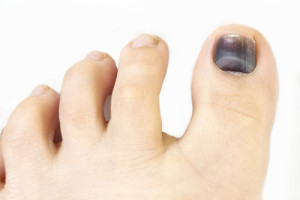 Toenail fungus or onychomycosis is a common disease that affects the nails. Contrary to popular opinion, most toenail infections start on the skin and then spread to adjacent nails. Over time, infected toenails may change color and turn black. Here is some more information about toenail fungus and toenail discoloration:
Toenail fungus or onychomycosis is a common disease that affects the nails. Contrary to popular opinion, most toenail infections start on the skin and then spread to adjacent nails. Over time, infected toenails may change color and turn black. Here is some more information about toenail fungus and toenail discoloration:
Causes
According to the Virginia Commonwealth University, some of the causative agents of toenail infections include: yeasts, dermatophytes, and nondermatophyte molds.
You can pick up any of the aforementioned fungi at a swimming pool, in a shower/bathroom, while walking barefoot outdoors, or locker room. Still, it is important to note that toenail fungus tends to thrive in damp, warm, and dark environments. People who suffer from plantar hyperhidrosis, wear ill-fitting shoes, apply too much nail polish, or have bad foot hygiene are more likely to pick up fungus.
The American Podiatric Medical Association (APMA) states that diabetics and people with immune deficiency problems or circulatory problems are more susceptible.
Symptoms
The first sign of a toenail infection is usually a yellow or white spot appearing beneath a nail. After a few days or weeks, the whitish or yellowish spot thickens and the affected nail starts to distort. As the infection progresses, the nail begins to crust and acquire a darkish color. At the same time, infected nails peel off from the nail bed, become painful, and may emit a foul smell. Other symptoms include tenderness in affected nails, crumbling toenails, and debris buildup beneath nails.
Black Toenail Fungus
The toenail fungus is preventing the nails from getting all the nutrients they require to grow properly. This is because nails consist of living cells that require certain nutrients to grow. As such, nails get nourishment from the body via blood vessels and lymph vessels that form part of the nail bed. On average, nails grow at a rate of about 3 mm in a month. However, infections, diseases, and injuries can interfere with normal growth patterns of nails. They ultimately cause nail abnormalities such as thickening, discoloration or splitting.
Other Discolorations
Infected toenails may also turn yellow or white, according to the American Academy of Dermatologists (AAD). This is especially true for people suffering from rheumatoid arthritis, sinusitis, cancer, and bronchiectasis.
Treatment
If you suspect that you have picked up a toenail fungus infection, you should seek treatment as soon as possible.
Besides oral medications, your doctor may prescribe antifungal creams or gels to prevent the infection from spreading. In cases where patients have severe and extremely painful infections, laser surgery is usually the preferred way to go.


